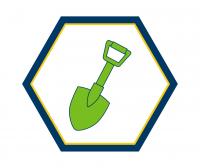Introduction
Thorough site preparation is an essential step in the restoration of pollinator habitat. The main reason that projects fail is due to insufficient control of problem weeds prior to seeding. In some cases, a year or longer may be needed to ensure that aggressive weeds are sufficiently controlled.
Agricultural Areas
Previous Land Use
Toolbox Home
In many cases, projects occur in fields that were previously in soybeans or corn, and agricultural production can help ensure that weeds are controlled prior to planting. However, it is important that pesticides (such as neonicotinoids) that persist in the soil were not used prior to planting. These can be taken up into plant tissues and can consequently affect pollinators. It is also important that pre and post emergent herbicides are not used prior to planting as they can prevent germination of native seeds. Additional control of Canada thistle and other persistent weeds may be needed in fields before seeding. Sites that are in perennial vegetation, such as smooth brome grass, goldenrod, etc., will require intensive management prior to planting. This may include a combination of mowing, herbicide application and repeated tilling to prepare for seeding or putting these areas into agricultural production for a year or two.
Fields that have been plowed or disked should be cultipacked or rolled prior to seeding. A firm but not compacted seedbed is required particularly if a native seed drill will be used for seeding.
Cover Crops
Cover crops such as oats or winter wheat can be used to stabilize soils and to provide additional time for pesticides to break down in the soil, or to stabilize soils prior to the planned seeding date. Cover crops can also provide additional time for weed control. They can be harvested or chopped prior to seeding and may need treatment with herbicide in some cases to prevent competition with seedlings.
Urban Areas
Urban pollinator habitat is increasing recognized for its importance in providing refuge to pollinators like the Rusty-Patched Bumblebee. Citizen-science organizations like the Xerces Society, Blue Thumb, and Lawns to Wildflowers offer suggestions for pollinator bed establishment and opportunities to collaborate with national pollinator research.
Sod Removal
In residential yards or smaller plantings in parks it is recommended to cut away the sod prior to planting to effectively remove weed roots and seeds. This can be accomplished with sod cutters, sod kickers or shovels for smaller areas. Herbicide application followed by tilling can also be used for preparing area of sod but several rounds of herbicide and tilling may be needed for sufficient control. Alternatively, the Xerces Society has developed a guide to organic site preparation methods such as the use of clear plastic to control weeds (solarization).
Overseeding Turf
Converting a turf-grass lawn to a Pollinator-Friendly Lawn is an excellent way to add habitat value to places that may not be suitable for larger pollinator plantings. It can be tricky to add low-growing flowering plants to an existing lawn. For suggestions to a successful conversion, see the Blue Thumb guide to establishing a Pollinator-Friendly (Bee) Lawn.
Soil Stabilization
If planting won't be conducted immediately cover crops such as oats can be used to stabilize planting areas and provide weed competition. Cover crops are also effective at improving soil health prior to planting and are a good option to prepare projects for planting seed in the fall which is the most common timing for pollinator projects. Erosion control fabrics should be planned for areas with steep slopes. Containerized plants can be installed directly into erosion fabric by cutting holes for planting.


